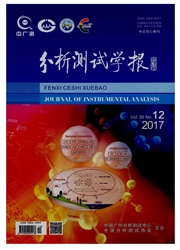

 中文摘要:
中文摘要:
本研究在玻碳电极(GCE)表面电沉积金纳米粒子(Au NPs),通过化学吸附将微囊藻毒素-(亮氨酸-精氨酸)(MC-LR)的单克隆抗体(anti-MC-LR)固定在电沉积了Au NPs的玻碳电极表面,以牛血清白蛋白(BSA)封闭非特异性吸附位点,制得免疫电极anti-MC-LR/Au NPs/GCE。采用微乳化法制备了掺杂三(2,2'-联二吡啶)钌(Ⅱ)配合物离子(Ru(bpy)2+3)的二氧化硅纳米粒子(Ru@SiO2),利用透射电镜和扫描电镜对所制备的纳米粒子进行表征。3-氨基丙基三乙氧基硅烷(APTS)进一步与Ru@SiO2反应,制得氨基功能化的Ru@SiO2,通过1-(3-二甲氨基丙基)-3-乙基碳二亚胺(EDC)和N-羟基琥珀酰亚胺(NHS)活化辣根过氧化物酶标记的MC-LR(HRP-MC-LR),并使其与氨基功能化的Ru@SiO2偶联,制得MC-LR-Ru@SiO2。采用直接竞争模式,在标记物MC-LR-Ru@SiO2存在下,以三丙胺作为共反应物,利用电化学发光法(ECL)测定溶液中的微囊藻毒素,免疫反应完成后,电化学发光强度(I)随着MC-LR浓度的增大而减小,且在0.100~100μg/L范围内,电化学发光强度差值(ΔI)与游离的MC-LR浓度的对数呈良好线性关系,检出限为0.007μg/L。对实际水样进行了加标回收实验,回收率为95.5%~105%。
 英文摘要:
英文摘要:
Gold nanoparticles( Au NPs) were electrodeposited onto the surface of a glassy carbon electrode( GCE). The antibody of microcystin-( leucine-arginine)( anti-MC-LR) was immobilized on the film surface of Au NPs by the adsorption between Au nanoparticles and antibody. Non-specific adsorption sites on the Au NPs were blocked with bovine serum albumin( BSA) to prepare an immunoelectrode anti-MC-LR / Au NPs / GCE. Microemulsion polymerization method was adopted to synthesize silica nanoparticles doped with tris( 2,2'-bipyridyl) ruthenium( Ⅱ) complex ions( e. g. Ru@SiO2). Ru@ SiO2 nanoparticles and Au NPs on the surface of a GCE were characterized by transmission electron microscopy image( TEM) and scanning electron microscopy( SEM),respectively. The Ru@ SiO2 nanoparticles were further modified with amino groups by reacting with 3-aminopropyltriethoxysilane. The amino group modified Ru@ SiO2 was then crosslinked with the carboxylic groups of microcystin-( leucine-arginine)( MC-LR) by ethyl-3-( dimethyl aminopropyl) carbodiimide( EDC)and N-hydroxysuccinimide( NHS) to prepare Ru@SiO2-conjugated MC-LR( MC-LR-Ru @SiO2). The immunosensor was based on the direct competitive immunoassay format between the labeled agent of MC-LR-Ru @ SiO2 and the analyte. In the presence of MC-LR-Ru@SiO2,tripropylamine( TPA) was used as coreactant. MC-LR in solution was determined by electrochemiluminescence( ECL) method. The ECL intensity( I) decreases with the increase of MC-LR concen-tration after antigen-antibody reaction. A good linear relationship between the change of ECL intensity( ΔI) and the logarithm of MC-LR concentration was obtained in the range of 0. 100-100 μg / L with a detection limit of 0. 007 μg / L. The developed ECL immunosensor was used to determine MC-LR in real water samples with recoveries of 95. 5%-105%.
 同期刊论文项目
同期刊论文项目
 同项目期刊论文
同项目期刊论文
 期刊信息
期刊信息
